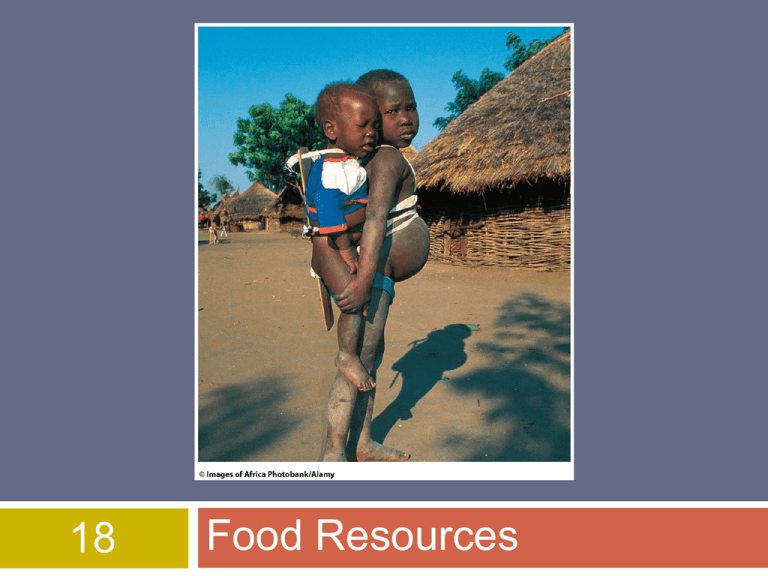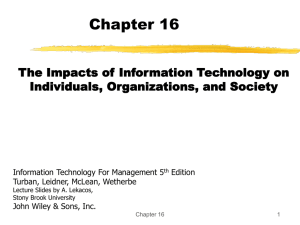
18
Food Resources
Overview of Chapter 18
World Food Security
Food Production
Challenges of Producing More Crops and
Livestock
Environmental Impact of Agriculture
Solutions to Agricultural Problems
Fisheries of the World
© 2012 John Wiley & Sons, Inc. All rights reserved.
World Food Security
Feeding growing population is difficult
Annual grain production (below) has increased from
1961–2008
Due to increase in population, amount of grain per
person has not increased
© 2012 John Wiley & Sons, Inc. All rights reserved.
World Food Security
Famine
Temporary
but severe shortage of food
Developing nations of Africa, Asia and Latin
America are most at risk
More people die from starvation than famine
© 2012 John Wiley & Sons, Inc. All rights reserved.
World Food Security
Maintaining Grain Stocks
Amounts
of rice, wheat, corn and other grains
remaining from previous harvest
Provides measure of food security
Decreased each year since mid 1980’s
In 2010, UN estimated that carryover stock would
last 72 days
© 2012 John Wiley & Sons, Inc. All rights reserved.
Decline in Grain Stock
Rising temps
Falling water tables
and droughts
Ethanol production
More grain is going
towards feeding
livestock
Increased meat
consumption in
developing countries
© 2012 John Wiley & Sons, Inc. All rights reserved.
World Food Security
Economics and Politics
Cost
money to store, produce, transport and
distribute food
Getting food to those who need it is political
Poverty and Food
1.3
billion people are so poor they cannot afford
proper nutrition
More common in
Rural
than urban areas
Infants, children and the elderly
© 2012 John Wiley & Sons, Inc. All rights reserved.
Food Production
© 2012 John Wiley & Sons, Inc. All rights reserved.
Animals as food
Constitute 40% of the calories consumed in
developed countries
Only comprise 5% of calories consumed in
developing countries
© 2012 John Wiley & Sons, Inc. All rights reserved.
Principle Types of Agriculture
Industrialized agriculture
Modern
agriculture methods that require large
capital input, and less land and labor
Subsistence Agriculture
Traditional
agricultural methods, which are
dependent on labor and large amounts of land
Shifting cultivation, Slash and burn agriculture,
Nomadic herding, Intercropping
© 2012 John Wiley & Sons, Inc. All rights reserved.
Energy Inputs in Industrialized
Agriculture
© 2012 John Wiley & Sons, Inc. All rights reserved.
Challenges of Producing More
Crops
Domestication and
Genetic Diversity
Domestication
of crops
and livestock causes a
loss of genetic diversity
Farmer selects and
propagates animals
with desirable
agricultural
characteristics
© 2012 John Wiley & Sons, Inc. All rights reserved.
Challenges of Producing More
Crops
Increasing Crop Yield
Food production increased in developed
countries
Pesticides
Selective
breeding
© 2012 John Wiley & Sons, Inc. All rights reserved.
Challenges of Producing More
Livestock
Increasing Livestock Yields
Hormone
US
supplements
and Canada, not used in Europe
Antibiotics
40%
of antibiotics produced in US are used in
livestock operations
Problems with increased bacteria resistance- some
bacteria are resistant to every antibiotic known
© 2012 John Wiley & Sons, Inc. All rights reserved.
Antibiotic Use and Resistance
© 2012 John Wiley & Sons, Inc. All rights reserved.
Genetic Engineering
Manipulation of genes by taking specific gene
from a cell of one species and placing it into
the cell of an unrelated species
Used to produce Genetically Modified (GM)
food
Ex:
golden rice - rich in beta carotene (prevent
Vitamin A deficiency in developing countries)
Plants that are tolerant to insect pests, heat, cold,
drought, or acidic soils
More productive farm animals
© 2012 John Wiley & Sons, Inc. All rights reserved.
© 2012 John Wiley & Sons, Inc. All rights reserved.
Unmodified corn (left); drought
resistant GM corn (right)
© 2012 John Wiley & Sons, Inc. All rights reserved.
© 2012 John Wiley & Sons, Inc. All rights reserved.
Safety in Genetic Engineering
Determined to be safe for human consumption
Concerns about GMO seed or pollen
spreading in wild
Currently
does not appear to be an issue
Long term unknown
Backlash against GMOs - especially in Europe
GMOs are not currently labeled
FDA
finds it would be counterproductive and
expensive to label
© 2012 John Wiley & Sons, Inc. All rights reserved.
Environmental Impacts of
Agriculture
© 2012 John Wiley & Sons, Inc. All rights reserved.
Solutions to Agricultural ProblemsSustainable Agriculture
Agricultural methods that maintain soil
productivity and a healthy ecological balance
while having minimal long-term impacts
© 2012 John Wiley & Sons, Inc. All rights reserved.
Sustainable Agriculture
Examples:
Natural
Predator-prey relationships instead of
pesticides
Crop selection
Crop rotation and conservation tillage
Supplying nitrogen with legumes
Organic agriculture
Integrated Pest Management (IPM)
Limited
use of pesticides with sustainable
agriculture practices
© 2012 John Wiley & Sons, Inc. All rights reserved.
Fisheries of the World - Problems
No nation lays claim to open ocean
Resource
susceptible to overuse and degradation
Overharvesting
Many
species
are at point of
severe depletion
62% of world’s
fish stock are in
need of
management
action
© 2012 John Wiley & Sons, Inc. All rights reserved.
Fisheries of the World - Problems
Overharvesting
(continued)
Sophisticated
fishing equipment
Bycatch killed off
Magnuson
Fisheries
Conservation Act
© 2012 John Wiley & Sons, Inc. All rights reserved.
World Seafood Harvest
© 2012 John Wiley & Sons, Inc. All rights reserved.
Fisheries of the World - Problems
Ocean Pollution - dumping ground
Oil
Heavy
metals
Deliberate litter dumping
Storm water runoff from cities and agricultural
areas
Aquaculture
Growing
of aquatic organisms for human
consumption
Great potential to supply food
© 2012 John Wiley & Sons, Inc. All rights reserved.
Fisheries of the World - Problems
Aquaculture (continued)
Locations
of fisheries may hurt natural habitats
Produce waste that pollutes adjacent water
© 2012 John Wiley & Sons, Inc. All rights reserved.




